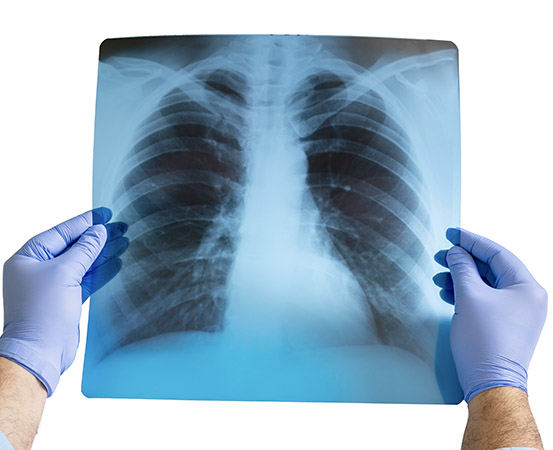
In 2013, an engineering student from Amritsar, Punjab suffered from acute cough and breathing difficulty. Avanti (name changed) was 19-years-old then and could not figure out the cause of her debilitating cough and breathing difficulty which had led to a worrisome heavy chest. She was diagnosed with interstitial lung diseases (ILD).
ILD is a group of respiratory diseases where the interstitium, the tissues in and around the alveoli (air sacs) of the lungs, get affected. While the symptoms of most lung diseases overlap, the diagnosis of ILD is very tricky.
Interstitial lung diseases; often misdiagnosed
In most cases it is initially misdiagnosed, like in the case of Avanti who was treated for over six months with anti-tuberculosis medicine.
Recounting Avanti’s case, Dr Neeru Bansal, Associate Professor and HOD, pulmonary medicine, Christian Medical College & Hospital, Ludhiana, Punjab said that the girl suffered from frequent bouts of cough and breathlessness that refused to subside with cough relieving medications.
“What made matters worse for Avanti was a misdiagnosis of tuberculosis for which she was treated earlier,” said Dr Bansal. When her team examined Avanti, they were rather shocked that she was prescribed antituberculosis drugs (ATDs). Unfortunately, her symptoms of ILD had worsened with the ATDs. “When she showed no signs of improvement, a CT scan was done to probe her unresponsiveness to the prescribed medicines,” said Dr Bansal.
“Through the CT scan, her actual diagnosis of Interstitial Lung Disease was uncovered. By the time she received the accurate diagnosis, it had progressed,” says Dr Bansal. She adds that it was unusual for a 19-year-old to have ILD, as it is usually seen in older adults. “She had idiopathic ILD, where the cause is not known,” Dr Bansal pointed out.
Avanti was administered steroids and antifibrotic medicines to curb the progression of her condition and has been on medications for ten years now. Avanti, now 29, must have regular follow-ups with her treating doctor.
What are interstitial lung diseases?
According to Dr Ravi Teja Buddha, consultant pulmonologist, Sahasra Clinic, Hyderabad, Interstitial lung diseases (ILDs) are a group of over 200 lung conditions that affect the interstitium.
Alveoli are air-sacs in the lungs that facilitate gas exchange. The oxygen inhaled moves through the alveoli to the bloodstream, to be supplied to other parts of the body.
“Interstitial lung disease, also called diffuse parenchymal disease, is the inflammation and scarring of the interstitium. The scarring makes the interstitium impermeable, affecting the flow of oxygen to the alveoli, resulting in the body not getting enough oxygen,” Dr Buddha told Happiest Health.
Types of ILDs
Dr Bansal, elaborates on the four type/categories of ILDs:
- Occupational ILD: Caused by inhaling harmful dust particles like coal dust, asbestos and silica at workplaces associated with mining, quarrying and blasting. Some occupational ILDs include asbestosis (caused by inhaling asbestos) and silicosis (caused by inhaling silica dust).
- Drug induced interstitial lung diseases (DIILD): Certain medications can induce inflammation and scarring of the lungs, leading to ILD. Treatments for cancers like chemotherapy, radiation therapy and certain antibiotics and immunosuppressants may prove harmful for the lungs.
- Autoimmune and connective tissue diseases induced: Persons with long standing autoimmune and connective tissue disorders like rheumatoid arthritis (a disease affecting the joints), lupus (an autoimmune disease that causes joint pain and skin rashes) can develop pulmonary complications including interstitial lung diseases.
- Idiopathic ILDs: These are the most common type and don’t have a known cause.
Symptoms and diagnosis of ILDs
According to Dr Bansal, interstitial lung diseases manifest as persistent cough, breathing difficulties and chest pain. These symptoms are progressive and not affected by the usual cough medications.
Shedding light on the diagnostic measures for ILDs, Dr Buddha, says, “The gold standard for diagnosis of ILD is a chest HRCT (High resolution computed tomography). A Bronchoscopic Lung Cryobiopsy (BLC) in which a part of the lung tissue is taken out and examined is also done.”
Treatment and prognosis
According to Dr Bansal, the primary treatment is steroids and antifibrotic medications. The person may also need assisted ventilation like home oxygen therapy and BiPAP. Sometimes the condition may also entail a lung transplantation.
Takeaways
- ILDs scar the tissues in and around the alveoli.
- There are over 200 types of interstitial lung diseases.
- ILDs can be caused by occupational exposure, medications and autoimmune conditions.
- Idiopathic interstitial lung diseases, the most common ILDs, have no known cause.


















One Response
Highly knowledgeable and very useful for senior people. A real, practical approach for healthy living.